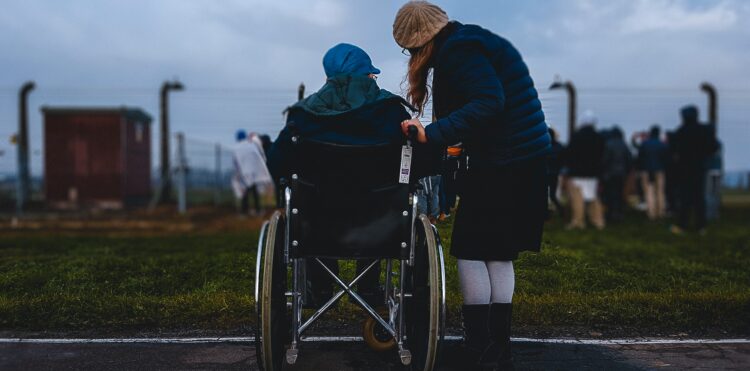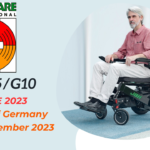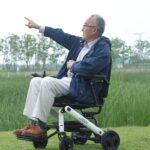Wheelchair Industry in 2021: A Closer Look at Why the Demand Has Surged!
Imagine your parents getting elderly, maybe dad can’t drive anymore or mom needs a walker or wheelchair to get around. Their disabilities would place additional demands or challenges on the entire family system. These demands could last for the unforeseeable future.
We are all susceptible to mobility disabilities regardless of age, whether, through accidents, aging, or medical conditions. Few family caregivers are prepared for the demands of immobile people.
It gets difficult for the elderly to perform trivial tasks like going up the stairs, so they mostly require assistance with virtually everything. Even showering seems more strenuous and takes longer. The daily strain of assisting and care leads to fatigue and exhaustion, taxing the emotional and physical energy of caregivers and family members.
If you face this situation in your family, your immediate instinctive reaction would be to try and save your loving mom or dad. A special Health Report from Harvard Medical School notes that loss of mobility in older adults is quite common and can have intense psychological, physical, and social consequences.
Geriatrician and instructor at Harvard Medical School, Dr. Suzanne Salamon, writes; “If you’re unable to get out then you can’t go shopping, you can’t go out with your friends to eat dinner or go to the movies, and you become dependent on other people to get you places.
So, you become a recluse, you stay home, you get depressed. With immobilization comes incontinence, because you can’t get to the bathroom, you can develop urinary infections, skin infections. The list goes on,”
What Issues Could Affect Your Mobility?
It is important to be aware of conditions that can result in immobility or make you bedridden. A report by Cynthia Brown from Louisiana State University titled “Mobility Limitation in The Older Patient: A Clinical Review” states that; the most popular risks that lead to mobility impairment include obesity, lack of physical activity, lack of proper balance of strength, and chronic diseases such as arthritis or diabetes.
She added that several tools are available to assist those who have difficulty walking. For instance, physical therapy is vital for assessing the extent of impairment. This will enable the therapists to recommend appropriate treatment measures. There has been strong evidence suggesting that balance and resistance exercises improve balance disorders and physical weaknesses that limit mobility.
Other risk factors include recent hospital stay, dementia, and depression. Moreover, being bedridden could also put you at risk of skin infections, incontinence (involuntary defecation or urination), and bedsores. To mitigate these risks caregivers must stay vigilant to diagnose these symptoms early
But don’t worry; the medical report has a silver lining. It notes that a senior’s mobility problems are treatable if consistent care and attention are given. The report concludes with the recommendation that regular checkups for ambulatory issues could help mitigate the risk of immobility in seniors. Moreover, regular exercise use of assistive mobility tools could enable those affected to live normal healthy lives.
If your parents ever face these challenges, they would need constant and dedicated support daily. Having to juggle the multiple aspects of caregiving can quickly become challenging. A family caregiver risks burning out and losing patience. "The Caregiver Alliance", an organization that aims to improve the quality of the life for family caregivers and the people who receive their care, states that;
“Most caregivers are ill-prepared for their role and provide care with little or no support, yet more than one-third of caregivers continue to provide intense care to others while suffering from poor health themselves.”
The family caregiver is at risk of depression, physical pains, anxiety, and even total mental collapse if proper support is not given to them.
Furthermore, the costs of providing family caregiving services can be quite high. A statistic from Family Caregiver Alliance found that the financial consequences of giving care to elderly people have a huge cost appetite. You need to pay as much as $659,139 over an entire lifetime including $25,494 for social security benefits, $566,443 for foregone wages, and $67,202 for pension benefits. From those numbers, it would therefore be financially wise to look for outside long-term care services.
Why Seniors Could Need Wheelchairs?
Falls from the top – This has always been a major risk factor for seniors. CDC statistics indicate that each second of each day, an older adult, age 65 and over, suffers a fall in the United States. —making falls the leading cause of injury and death in this age group. A fall diminishes function by causing loss of mobility, injury, or activity limitations.
Physical and Emotional Abuse – Physical elder abuse is any form of harm or violence that leaves a senior person significantly injured. This is unfortunately another risk for seniors. The perpetrators can be caregivers, family members, or nursing home staff.
Sadly, some may take advantage of a senior persons’ dependency and weakness, and cause them harm. And because a seniors’ body is weaker, even a single case of abuse can cause long-term health issues or even death.
Traffic Accidents – Statistics indicate that nearly 7,700 seniors lost their lives in car accidents in 2018 while another 250,000 received treatment in emergency departments for car crash injuries. Regrettably, some seniors in these statistics were unfit to drive therefore posing a danger to not only themselves but other road users as well.
Fire Accidents – Fires from cooking, smoking, and heating equipment are a leading cause of death for seniors. And when these fires occur, a senior left alone might not react quickly to mitigate these emergencies hence highly at risk of serious injury and death. Being aware of these concerns can enable you to take proper safety measures to protect your loved ones.
What are the Safety Precautions for Seniors?
If you live with a senior, you must take all precautions necessary to minimize hazards and ensure their mental and physical safety. For instance, if you live with a senior who needs a wheelchair, you must ensure that the home has a ramp and that doorways are wide enough to fit the chair. Handlebars may also be necessary to provide support in places like bathrooms. You also need to have proper fire safety measures like a fire extinguisher, smoke detector, and an evacuation plan.
How The Demand for Wheelchairs Is Impacting the World?
The WHO (World Health Organization) estimates that more than 1 billion people suffer from some sort of disability. Another study found that 24% of adults age 65 and older used a mobility aid in 2011. Moreover, chronic diseases are noted to be an increasing cause of disability which also creates a need for wheelchairs.
A statistic indicates that out of the over 1 billion people in India, about 2.21% suffer some sort of disability. This has meant that the developing country has a forecast of mobility aids becoming a key source of revenue for companies like wheelchair manufacturers. India has one of the highest global rates of road accidents, which leaves many with disabilities. Though wheelchair adoption is still low, government initiatives and consumer awareness is foreseen to boost demand in the coming years.
The recent technological evolution of wheelchair designs is also anticipated to drive demand and sales in the future. The availability of battery-driven wheelchairs will also be a great driving factor for wheelchair adoption. Other innovative wheelchair capabilities are also driving demand. These include; distress call systems in case of emergency, storage of patient’s medical history, and real-time health monitoring systems.
For instance, Invacare AVIVA FX Power Wheelchair is a brand name launched by Invacare Corporation in March 2020. This front-wheel-drive chair is easy to control and can comfortably travel on all terrain including uneven surfaces, curbs, and slopes.
According to market research, from 2015 to 2019, the wheelchair and components market expanded at 3.4% CAGR.
The COVID-19 pandemic had a devastating impact on the healthcare and medical industries. Supplies chain disruption has been synonymous with the crisis due to lockdowns and travel restrictions. The world is now a global village due to the efficient linking of supply chains. The pandemic has resulted in a shortage of wheelchair components such as frames and rims. Estimates indicate that over 90% world's annual medical device exports come from countries currently under some form of lockdown.
To mitigate the crisis, businesses have been quick to look at scaling and prioritizing digital solutions such as online education, webinars, conferences for industry professionals, and having customer service representatives. Regardless, normalcy seems to be returning to many vaccinated countries hence wheelchairs and components sales are foreseen to normalize.
The global wheelchair and accessories market is anticipated to grow by nearly 4% through 2030, as Persistence Market Research notes.
The Top Reasons for a Surge in Electric Wheelchairs Demand
Electric wheelchairs have many advantages over traditional ones. Some recent innovations enable electric wheelchairs to; pair with smart gadgets, make distress calls, store medical history, and monitor patient health in real-time. These chairs can also comfortably travel long distances with ease, thus increasing the users’ independence.
How Increase in Support and Funding Will Affect Wheelchair Manufacturers?
The Wheelchair Foundation is a non-profit organization whose goal is to provide every disabled adult, teen, and child with a wheelchair if they can’t afford one. They also aim to raise global public awareness about physical disabilities. Free Wheelchair Mission (FWM) indicates that globally about 70 million people need a wheelchair but don’t have access to one.
FWM’s vision is to provide mobility solutions to people from developing countries who have disabilities. Since 2001, FWM has distributed a remarkable 1.3 million wheelchairs in 94 developing countries across the globe. They aim to distribute another one million wheelchairs by the end of 2025. FWM also accepts wheelchair donations from the public.
Numerous other organizations offer support to children with disabilities, including, "The First-Hand Foundation", "Kids Mobility Network", "Challenged America", and many others. These institutions offer services such as rehabilitation, medicine, supplies, and many other services and products. Therefore, increasing NGO and governmental support for immobility issues is expected to boost wheelchair sales in the coming years
Why China Is the Most Lucrative Asian Market?
China is one of the countries that lead globally in road accidents. Therefore, it is not surprising that China is only second to India when it comes to the number of disabled persons. China’s advantage is its capable medical device industry that renders services inexpensively compared to other countries. This makes it the most appealing market in Asia. The country also has a huge presence of giant medical device manufacturers, a factor that will help foster substantial growth in sales of wheelchairs and components in the future.
The Cause of Demand Surge for Powered Wheelchairs
Revenue from the global wheelchair market is projected to reach $7.8 billion by 2025, at a 7.9% CAGR between 2021 and 2025. This drastic surge is attributed to aging populations, a rise in spinal cord injuries, and increasing awareness and innovation of wheelchairs. For example, January 2018 saw the launch of WHILL Model Ci Personal EV Smart Electric Vehicle (PEV), a wheelchair developed to help eliminate self-consciousness associated with traditional wheelchairs.
Why Many Prefer Lightweight Wheelchairs?
Many users prefer lightweight wheelchairs over traditional ones because they are easier to maneuver, propel, store, and transport. These factors are especially vital for disabled individuals due to their simplicity and convenience.
The Competition in the Market
Leading market players are looking to make regional level acquisitions, a trend currently seen across North America, Europe, and Asian countries like Japan and China. Companies have to innovate to stay afloat and maintain competitiveness, while still ensuring a strong product pipeline.
Medical device companies keep identifying possible assets from smaller organizations with limited resources for bringing their products to market. Therefore, partnerships and licensing deals have become necessary for companies to acquire new product lines, while still executing their in-house development goals and strategies.
- For example, Permobil announced an agreement on January 10, 2018, about acquiring the business assets of Ottobock’s OBSS and NUTEC custom seating. Both of them were in the USA and CANADA. This was a strategic move for expanding the seating offering of the company with various positioning solutions in the industry.
- In February 2020, Numotion, the leading US provider of CRT (Complex Rehab Technology) services, acquired the leading CRT provider in New York State, Monroe Wheelchair (“Monroe”). This move will enable Numotion to broaden its capabilities and extend its reach throughout the greater Northeast region. Numotion has been offering CRT services in the US for over 75 years.
Bottom Line!
The bottom line is elderly people need wheelchairs for a better life. This is the prime reason why the demand is increasing in the world. So, if you are planning to buy or produce a wheelchair, be sure to step into a big industry where you will be pushed to the limits!





